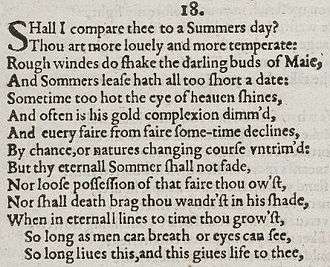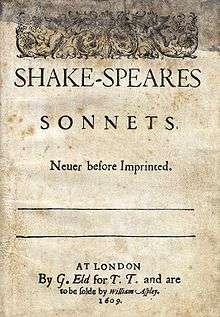Sonnet 18
Sonnet 18 is one of the best-known of the 154 sonnets written by the English playwright and poet William Shakespeare.
« » Sonnet 18 | |||||||
|---|---|---|---|---|---|---|---|
 Sonnet 18 in the 1609 Quarto of Shakespeare's sonnets. | |||||||
| |||||||
In the sonnet, the speaker asks whether he should compare the young man to a summer's day, but notes that the young man has qualities that surpass a summer's day. He also notes the qualities of a summer day are subject to change and will eventually diminish. The speaker then states that the young man will live forever in the lines of the poem, as long as it can be read.[1] There is an irony being expressed in this sonnet: it is not the actual young man who will be eternalized, but the description of him contained in the poem, and the poem contains scant or no description of the young man, but instead contains vivid and lasting descriptions of a summer day; which the young man is supposed to outlive.[2]
Structure
Sonnet 18 is a typical English or Shakespearean sonnet, having 14 lines of iambic pentameter: three quatrains followed by a couplet. It also has the characteristic rhyme scheme: ABAB CDCD EFEF GG. The poem reflects the rhetorical tradition of an Italian or Petrarchan Sonnet. Petrarchan sonnets typically discussed the love and beauty of a beloved, often an unattainable love, but not always.[3] It also contains a volta, or shift in the poem's subject matter, beginning with the third quatrain.[4] line 1: Rhetorical Question The couplet's first line exemplifies a regular iambic pentameter rhythm:
× / × / × / × / × / So long as men can breathe or eyes can see, (18.13)
- / = ictus, a metrically strong syllabic position. × = nonictus.
Context
The poem is part of the Fair Youth sequence (which comprises sonnets 1–126 in the accepted numbering stemming from the first edition in 1609). It is also the first of the cycle after the opening sequence now described as the procreation sonnets. Some scholars, however, contend that it is part of the procreation sonnets, as it addresses the idea of reaching eternal life through the written word, a theme they find in sonnets 15–17. In this view, it can be seen as part of a transition to sonnet 20's time theme.[5]
Notes on the text
"Complexion" in line six, can have two meanings:
- (1)The outward appearance of the face as compared with the sun ("the eye of heaven") in the previous line, or
- (2)The older sense of the word in relation to The four humours.
In Shakespeare's time "complexion" carried both outward and inward meanings, as did the word "temperate" (externally, a weather condition; internally, a balance of humours). The second meaning of "complexion" would communicate that the beloved's inner, cheerful, and temperate disposition is constant, unlike the sun, which may be blotted out on a cloudy day. The first meaning is more obvious: a negative change in his outward appearance.[6]
The word, "untrimmed" in line eight, can be taken two ways: First, in the sense of loss of decoration and frills, and second, in the sense of untrimmed sails on a ship. In the first interpretation, the poem reads that beautiful things naturally lose their fanciness over time. In the second, it reads that nature is a ship with sails not adjusted to wind changes in order to correct course. This, in combination with the words "nature's changing course", creates an oxymoron: the unchanging change of nature, or the fact that the only thing that does not change is change. This line in the poem creates a shift from the mutability of the first eight lines, into the eternity of the last six. Both change and eternity are then acknowledged and challenged by the final line.[3]
"Ow'st" in line ten can carry two meanings, each common at the time: "ownest" and "owest". "Owe", in Shakespeare's day, was sometimes used as a synonym for "own". However, "owest" conveys the idea that beauty is something borrowed from nature—that it must be paid back. In this interpretation, "fair" can be a pun on "fare", or the fare required by nature for life's journey.[7] Other scholars have pointed out that this borrowing and lending theme within the poem is true of both nature and humanity. Summer, for example, is said to have a "lease" with "all too short a date". This monetary theme is common in many of Shakespeare's sonnets, as it was an everyday theme in his budding capitalistic society.[8]
Recordings
- Paul Kelly, for the 2016 album, Seven Sonnets & a Song
- Chuck Liddell Video on YouTube
- David Gilmour
- Bryan Ferry, for the 1997 album Diana, Princess of Wales: Tribute
Notes
- Shakespeare, William. Duncan-Jones, Katherine. Shakespeare’s Sonnets. Bloomsbury Arden 2010. ISBN 9781408017975. p. 146
- Hammond. The Reader and the Young Man Sonnets. Barnes & Noble. 1981. p. 27. ISBN 978-1-349-05443-5
- Jungman, Robert E. (January 2003). "Trimming Shakespeare's Sonnet 18". ANQ: A Quarterly Journal of Short Articles, Notes and Reviews. ANQ. 16 (1): 18–19. doi:10.1080/08957690309598181. ISSN 0895-769X.
- Preminger, Alex and T. Brogan. The New Princeton Encyclopedia of Poetry and Poetics. Princeton: Princeton University Press, 1993. pg. 894 ISBN 0-691-02123-6
- Shakespeare, William et al. The Sonnets. Cambridge: Cambridge University Press, 1996. pg. 130 ISBN 0-521-29403-7
- Ray, Robert H. (October 1994). "Shakespeare's Sonnet 18". The Explicator. 53 (1): 10–11. doi:10.1080/00144940.1994.9938800. ISSN 0014-4940.
- Howell, Mark (April 1982). "Shakespeare's Sonnet 18". The Explicator. 40 (3): 12. ISSN 0014-4940.
- Thurman, Christopher (May 2007). "Love's Usury, Poet's Debt: Borrowing and Mimesis in Shakespeare's Sonnets". Literature Compass. Literature Compass. 4 (3): 809–819. doi:10.1111/j.1741-4113.2007.00433.x.
References
- Baldwin, T. W. (1950). On the Literary Genetics of Shakspeare's Sonnets. University of Illinois Press, Urbana.
- Hubler, Edward (1952). The Sense of Shakespeare's Sonnets. Princeton University Press, Princeton.
- Schoenfeldt, Michael (2007). The Sonnets: The Cambridge Companion to Shakespeare’s Poetry. Patrick Cheney, Cambridge University Press, Cambridge.
- First edition and facsimile
- Shakespeare, William (1609). Shake-speares Sonnets: Never Before Imprinted. London: Thomas Thorpe.CS1 maint: ref=harv (link)
- Lee, Sidney, ed. (1905). Shakespeares Sonnets: Being a reproduction in facsimile of the first edition. Oxford: Clarendon Press. OCLC 458829162.
- Variorum editions
- Alden, Raymond Macdonald, ed. (1916). The Sonnets of Shakespeare. Boston: Houghton Mifflin Company. OCLC 234756.
- Rollins, Hyder Edward, ed. (1944). A New Variorum Edition of Shakespeare: The Sonnets [2 Volumes]. Philadelphia: J. B. Lippincott & Co. OCLC 6028485.
- Modern critical editions
- Atkins, Carl D., ed. (2007). Shakespeare's Sonnets: With Three Hundred Years of Commentary. Madison: Fairleigh Dickinson University Press. ISBN 978-0-8386-4163-7. OCLC 86090499.
- Booth, Stephen, ed. (2000) [1st ed. 1977]. Shakespeare's Sonnets (Rev. ed.). New Haven: Yale Nota Bene. ISBN 0-300-01959-9. OCLC 2968040.
- Burrow, Colin, ed. (2002). The Complete Sonnets and Poems. The Oxford Shakespeare. Oxford: Oxford University Press. ISBN 978-0192819338. OCLC 48532938.
- Duncan-Jones, Katherine, ed. (2010) [1st ed. 1997]. Shakespeare's Sonnets. The Arden Shakespeare, Third Series (Rev. ed.). London: Bloomsbury. ISBN 978-1-4080-1797-5. OCLC 755065951.
- Evans, G. Blakemore, ed. (1996). The Sonnets. The New Cambridge Shakespeare. Cambridge: Cambridge University Press. ISBN 978-0521294034. OCLC 32272082.
- Kerrigan, John, ed. (1995) [1st ed. 1986]. The Sonnets ; and, A Lover's Complaint. New Penguin Shakespeare (Rev. ed.). Penguin Books. ISBN 0-14-070732-8. OCLC 15018446.
- Mowat, Barbara A.; Werstine, Paul, eds. (2006). Shakespeare's Sonnets & Poems. Folger Shakespeare Library. New York: Washington Square Press. ISBN 978-0743273282. OCLC 64594469.
- Orgel, Stephen, ed. (2001). The Sonnets. The Pelican Shakespeare (Rev. ed.). New York: Penguin Books. ISBN 978-0140714531. OCLC 46683809.
- Vendler, Helen, ed. (1997). The Art of Shakespeare's Sonnets. Cambridge, MA: The Belknap Press of Harvard University Press. ISBN 0-674-63712-7. OCLC 36806589.
External links

- Paraphrase and analysis (Shakespeare-online)
- David Gilmour's recording of Sonnet 18 on YouTube
- Poeterra's recording of Sonnet 18
.png)
